When I yearn for a little quiet time, I head east to the beach or west to the Everglades. Specifically, the Loxahatchee Wildlife Refuge in Boynton Beach.
I bring a book, a camera and a chair and park my pickup on the levee separating the refuge from Conservation Area 2.
There’s something soothing to be out there on a weekday morning or afternoon. Weekends are OK too if you don’t mind the parade of airboats next door in Area 2. (They are not allowed in the refuge). Weekends also bring fishing boats to refuge boat ramps and crowds of hikers and bicycles on the levee trails.
On weekdays, you’ll most likely have it all to yourself.
Nearly 260 species of birds and waterfowl have been identified in this vast preserve of wet prairies, sawgrass marshes, sloughs and tree islands, more than a few perching within view of the levee.
Kayaks, canoes or a small motorboat will take you deeper into this 224 square-mile wilderness, where you may encounter one of the 23 species of mammals, 17 species of frogs and amphibians, 18 species of turtles and lizards and 24 species of snakes.
But whose counting!

The Arthur R. Marshall Loxahatchee National Wildlife Refuge is the last remaining swath of the northern Everglades. The rest has given over to agriculture, primarily sugar cane fields to its west and coastal development to the east, making this a very special enclave.
There are three visitor access areas that allow you to experience these sprawling wetland, reminiscent of South Florida before the dredges and bulldozers channelled water into drainage ditches for houses and crops.
Loxahatchee National Wildlife Refuge Visitor Center
The Loxahatchee National Wildlife Refuge Visitors Center, west of Boynton Beach, is the hub of this preserve, offering a variety of exhibits and activities to introduce and educate you to the refuge’s charms, including a virtual airboat ride.
South Entrance
The south entrance is from Lox Road, which runs 6 miles west from U.S. 441 along the Hillsboro Canal, which is on the Broward/Palm Beach county line.
North Entrance
The northern entrance is a recreation area at 20-Mile Bend on State Road 80 west of West Palm Beach.
Hiking at the Loxahatchee National Wildlife Refuge: Wildlife and experimental ecosystems
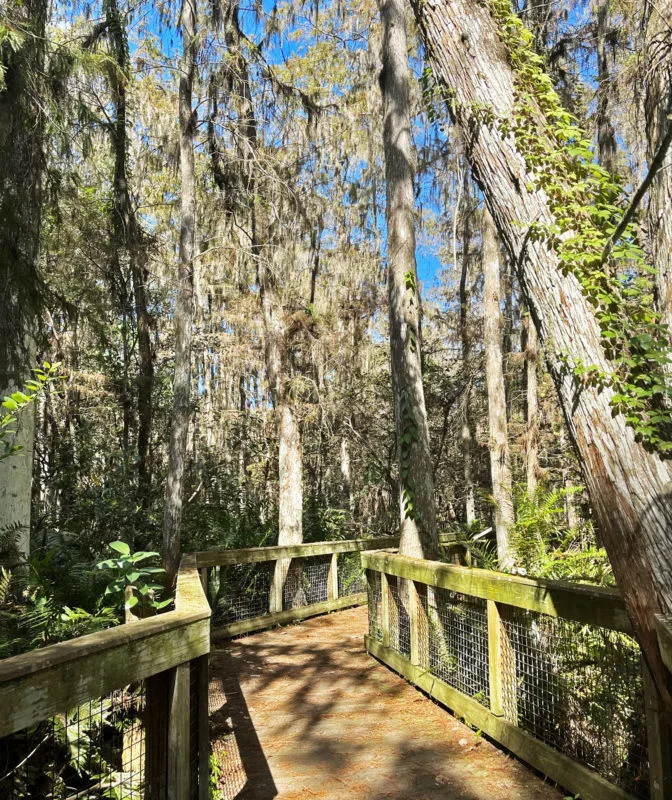
Behind the Loxahatchee National Wildlife Refuge Visitors Center is the Cypress Swamp Boardwalk, a half-mile trail through a beautiful forest of natural cypress. I thought this trail was the best feature of the park. The trail is shaded, cool and picturesque. If you stay still and remain quiet, you’ll see the wildlife going through their daily rituals.
Home to woodpeckers, owls and various species of songbirds, the 400-acre cypress swamp consists of pond cypress trees (check out their “knees,”) pond apple, myrsine, lichens and a variety of ferns. It is part of the largest cypress forest left on the east side of the Everglades, a forest that once extended uninterrupted from Lake Okeechobee to Fort Lauderdale.
Silence surrounded us as we enjoyed critters rustling through the undergrowth and a woodpecker hammering on a dying cypress tree. We were there in late morning, but the animals are more active at sunrise, when the refuge opens, and just before it closes at sunset.
We saw several photographers leaving the boardwalk as we arrived, a strong indication that we missed the action.
From the Cypress Swamp Boardwalk at Loxahatchee National Wildlife Refuge Visitor’s Center, hike out on the Marsh Trail, across the entrance road from the center, where you’ll find several miles of hiking along a network of trails laid out in a grid around eight landscape impoundment areas where scientists maintain and study different Everglades environments for restoration assessments and wildlife observation.
Each of the impoundments represents a different ecosystem, mimicking natural habitats in the Everglades for measurement of the impact changes will have as the Everglades are gradually restored. You can hike right into the middle of these experiments.
A ring of levees surrounds the refuge, supporting several trails, although restrictions have been imposed on how far you can go. Much of the levee system has been closed to hikers and bicyclists because they get lost or wander too far.
Before you hike, stop at the Visitors Center and pick up your Bird Checklist. Here’s a copy you can download.
You can see what birds have been seen lately at this eBird Trail Tracker.
Bicycling at Loxahatchee National Wildlife Refuge: The levee trail
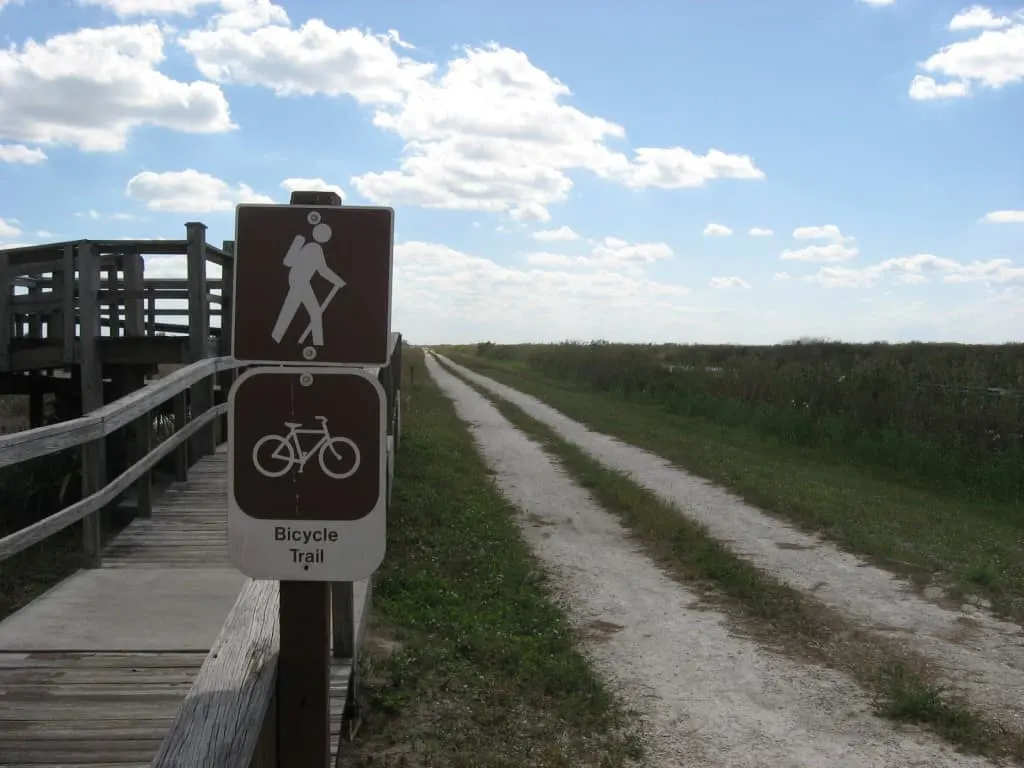
The Loxahatchee National Wildlife Refuge allows bicyclists on 45 miles of trails atop the levees that encircle the refuge, although the levees on the west and north sides are off-limitis.
The trail is hard-packed sand, actually a road used by park employees, and not conducive to narrow-tire bikes. A mountain bike or hybrid is recommended.
The 13-mile stretch of trail between the Main Visitor Center and the Lox Road entrance to the refuge is a popular section.
There is little or no shade on this trail atop the levee, so it is recommended that you bring water, helmet, sunscreen, and light snacks.
I’ve ridden this part of the levee, accessing the trail from the south end at Lox Road and enjoyed the experience of riding above the refuge and looking down into the wetlands to observe alligators and birds. It’s very quiet out there during the day, so stop occasionally and absorb the silence.
At night, the refuge comes alive with a cacophony of noisy bellows, grunts, croaks, twerping and insects, almost to the point of being a little scary!
You can enjoy these night sounds by arriving before dawn when the refuge opens at 5 a.m. or after sunset and before the refuge closes at 10 p.m.
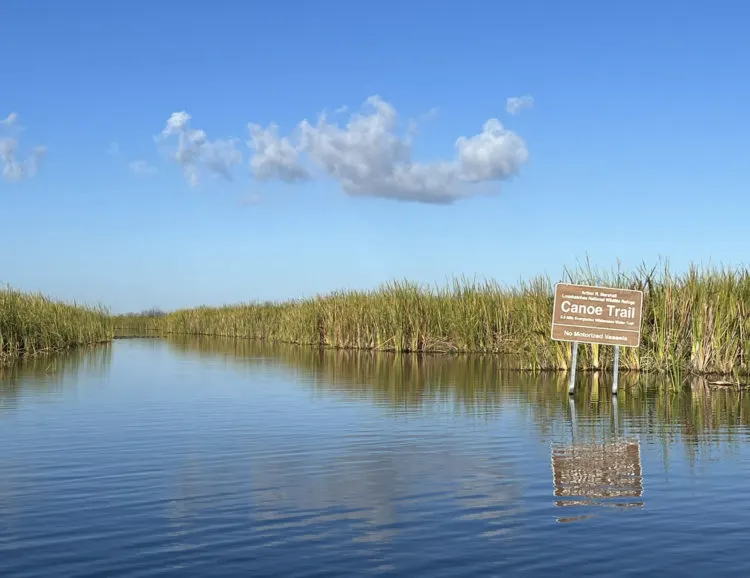
The Loxahatchee National Wildlife Refuge Canoe Trail
A 5 1/2-mile canoe trail starts from the boat ramp at the Main Visitor Center and takes you deep into refuge, allowing you to experience all of the elements that make up this pristine environment.
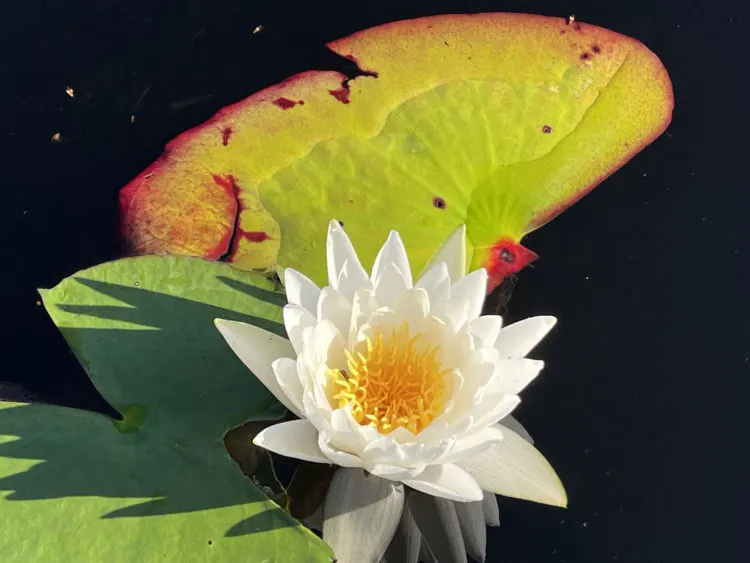
The trail winds through wet prairies, sawgrass marshes and tree islands, which are floating islands of peat upon which trees have taken root.
Near the halfway point of the trail is a platform where you can get out of your canoe and rest while observing wildlife and a beautiful, changing landscape that stretches as far as the eye can see.
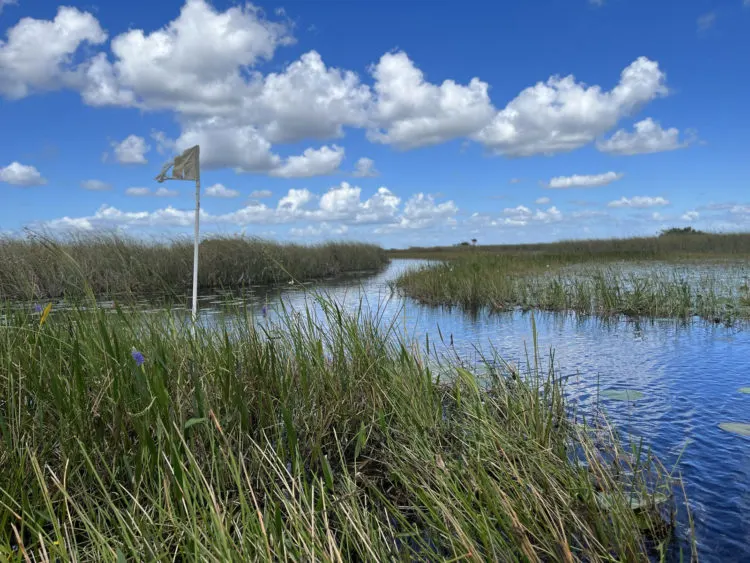
If you’re lucky, it is along this trail that you will find unusual and rare birds, especially in winter when the refuge is home to many migratory species. The wetlands along the trail are populated by deer, bobcats, frogs, turtles, butterflies and, of course, the ubiquitous alligator. No worries, they shouldn’t bother you as long as you don’t bother them.
The trail is easy to follow.
At times, the trail is clogged with water lilies, making it difficult to paddle through (but we did it). On a November 2022 visit, the trail had just been cleared and it was easy paddling (except the wind, which can make paddling difficult as the swamp has no vegetation to break the wind.)
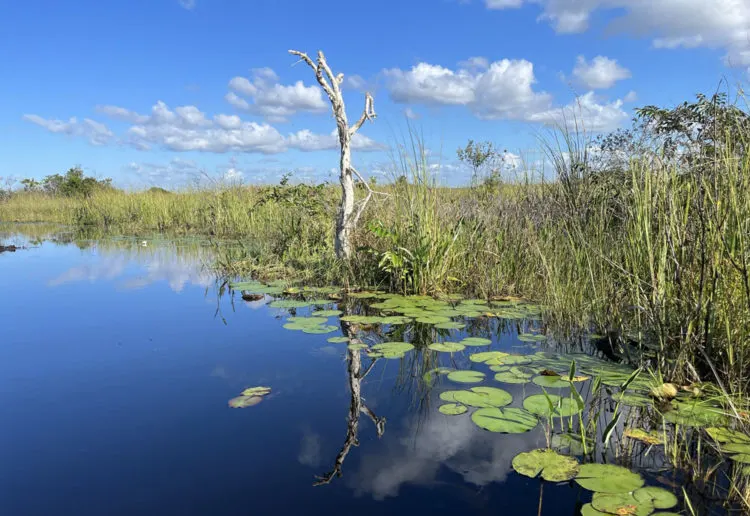
For trail conditions, you can check with the refuge headquarters (561-734-8303) or the canoe outpost at the ramp (561-733-0192).
Paddling is also permitted in other areas of the refuge that are open to the public, including the grassy wetlands at the southern end of the refuge, accessible from Lox Road. However, the designated canoe trail at the Main Visitors Center may provide the best experience of the preserve’s various eco-systems.
My wife and I paddled this trail in a canoe and were thrilled by the journey.
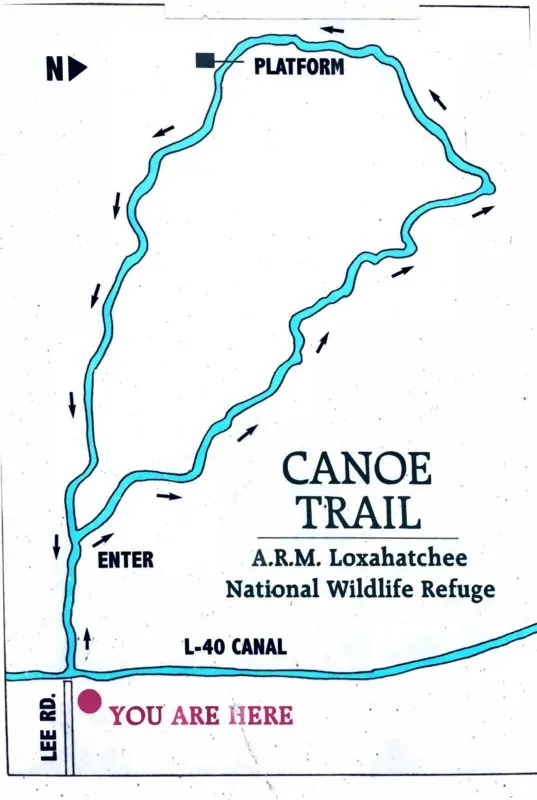
You can bring your own kayak or canoe and launch for the price of admission to the refuge ($10 per carload), or you can rent canoes, solo kayaks or tandem kayaks from Loxahatchee Adventures.
But be aware: 5.5 miles is a long paddle (a 3 to 4 hour trip at a leisurely pace) and the scenery does not change much. If it’s windy or threatening rain, consider that short-cut route.
For rentals or more information call (855) 916-5692 or connect with Loxahatchee Adventures on Facebook.
Motorboats OK in some areas of Loxahatchee National Wildlife Refuge, but no airboats
Only paddle boats are allowed on the canoe trail, but motorboats are permitted in the perimeter canal and other interior areas on the south end of the refuge at the Lox Road entrance.
Loxahatchee Adventures rents motorized jon boats at the Lox Road entrance as well as bikes and kayaks.
Boating is prohibited in northern half of the refuge’s interior, except in the perimeter canal.
Airboats are prohibited in all areas of the refuge. However, you can launch airboats in the adjacent Conservation Area 2, which is also accessible from Lox Road in Broward County.
All boats venturing into the southern interior of the refuge are required to have an orange flag atop a 10-foot pole so fast-moving motorboats can see you in the deep sawgrass and wet prairies.
The water is shallow in the southern interior, so motorboats especially should exercise caution. Large boats are impractical, but shallow-draft bass boats are quite common and can often be seen speeding into the weeds. These bass boats are allowed to travel up to 35 mph through the interior.
I’ve taken a motor-powered canoe into this area a few times. As you go deeper into the marsh, keep your eye out for landmarks so you can find your way back. It’s very easy to get turned around and lose your sense of direction. GPS is a very good idea.
State and federal boating regulations apply, and you don’t want to get caught without life jackets.
Boat ramps are accessible in Loxahatchee National Wildlife Refuge at these three locations:
- Lox Road: Lox Road is 100 feet south of the Palm Beach-Broward County line and then it angles back up into Palm Beach County alongside the Hillsboro Canal. Go six miles to the refuge entrance. There is a boat ramp just inside the refuge gate, as well as ample parking.
- Visitors Center: On Lee Road in Boynton Beach, off U.S. 441, about two miles south of Boynton Beach Blvd. After going through the entrance gate, drive straight back to the levee where the boat ramp is located. There’s a large lot for trailer parking.
- 20-Mile Bend: West of Royal Palm Beach and Wellington on Southern Boulevard (SR 80). The boat ramp is on the left side just before 20-Mile Bend. Restrooms and a fishing dock are available, along with trailer parking.
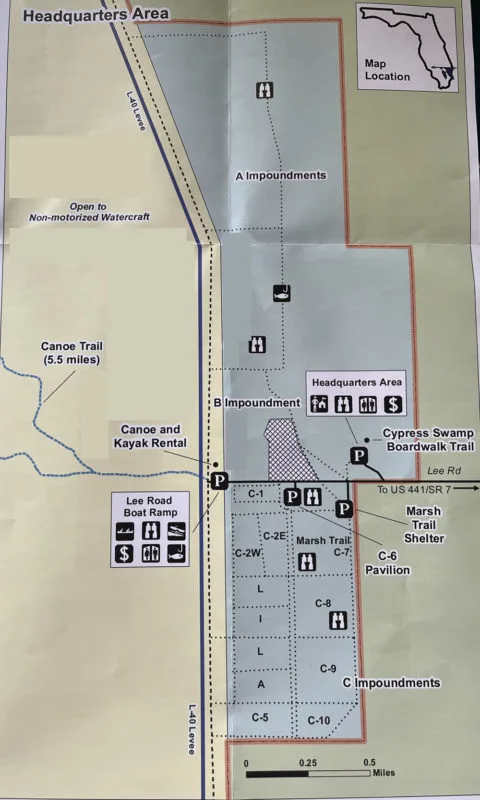
Fishing at Loxahatchee National Wildlife Refuge: A lunker bass awaits you
The fishing is fantastic in the refuge, as you might imagine.
At the Main Visitors Center, a popular fishing pier extends south of the boat ramp. When I visited recently, a 14-foot alligator hovered below the pier, obviously awaiting his next meal. If you get a bite, and you almost certainly will, retrieve your catch quickly or you will likely lose it.
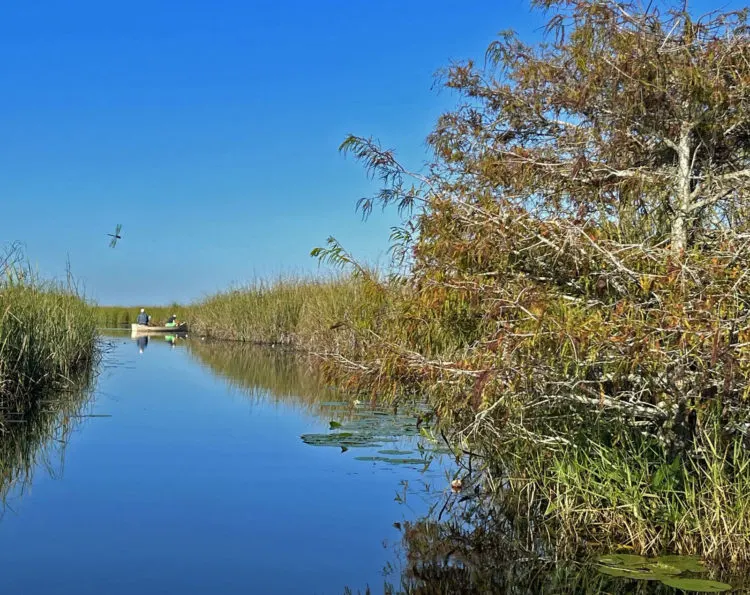
One time when I was fishing in the refuge, I hooked a long-nose garfish and was startled when an alligator steamed toward my catch and summarily snatched it from hook. Gone. Vanished. Not that I wanted the garfish, anyway.
But it reminded me that an alligator’s huge, muscular tail can propel him at unbelievable speeds, so keep your eyes peeled for dinner guests. Most times, though, the gators just lie in the water and watch.
I’ve fished the refuge with spinning roads and fly rods, and it’s not uncommon to see those long cane poles along the levees. For bait, I’ve used earthworms with the most success. On my fly rod, poppers and mouse flies seem to do the trick. I’ve also had excellent results with those big black bass bugs. You might also try dragonfly imitations, especially during a hatch, and there are many dragonfly hatches in the refuge.
Besides bass, you’ll find bluegill and panfish populations.
On any given day, you’ll find several people fishing from shore and the levees at the southern end of the refuge at Lox Road. Especially attractive spots are above and below the spillway into the Hillsboro Canal. You can also walk west on the levee to another spillway, where there’s a big open pool full of fish (and alligators).
The Arthur R. Marshall Loxahatchee National Wildlife Refuge
Admission: The admission fee is $10 per carload, or $1 per person for pedestrian and bicyclists. You can also obtain an annual pass at the Visitor Center. (Watch for annual free days , which have in the past been Martin Luther King, Jr., Day, Presidents’ Day, National Public Lands Day in September, the First Sunday of National Wildlife Refuge Week in October and Veterans Day.)
Hours: The refuge is open from 5 a.m. until 10 p.m. every day. The Main Visitor Center is open only from 9 a.m. to 4 p.m. Canoe and kayak rentals are available from 10 a.m. until 5:30 p.m. If you are paddling the 5 1/2 mile trail, you will need to leave the boat ramp no later than 2 p.m.
Volunteers: RV campers get a pad with full hookups at no cost in exchange for 35 hours of work per week, and you are expected to stay four weeks. Not a bad idea for winter visitors looking for something to do during your seasonal visits to Florida. There are three volunteer campsites available, and you have to go through an interview process.
If you already live in South Florida, contact the park office or Friends of the Loxahatchee National Wildlife Refuge by going to their web site. http://www.loxahatcheefriends.com
Links:
Loxahatchee National Wildlife Refuge map
U.S. Fish and Wildlife web site
Friends of the Arthur R. Marshall Loxahatchee Wildlife Refuge
Downloadable guides for the Great Florida Birding Trail
More things to do in northern Palm Beach County
West Palm Beach: Old city, modern vibe with awesome variety of things to do
A great beach at MacArthur State Park
Kayak to Munyon Island in MacArthur State Park
Lake Trail, a bike trail on the elite island of Palm Beach
Palm Beach: Full of history and manicured beauty
Peanut Island for snorkeling and camping
Hiking and bike trails at Grassy Waters Preserve, West Palm Beach
Great birding at Wakodahatchee and Green Cay Preserves
A good family bike destination: Riverbend Park in Jupiter.

Bob Rountree is a beach bum, angler and camper who has explored Florida for decades. No adventure is complete without a scenic paddle trail or unpaved road to nowhere. Bob co-founded FloridaRambler.com with fellow journalist Bonnie Gross 14 years ago.







Brian
Monday 24th of April 2017
How about paddle boarding in Loxahatchee? Any concerns of the alligators getting you? I would like to try fishing off a paddle board.
John
Wednesday 1st of February 2023
@Bonnie Gross,
Years ago we used to water ski in the perimeter canal, and we all still have all of our appendages. I can't imagine an alligator attacking a paddleboard, but I guess stranger things have happened.
Bonnie Gross
Tuesday 25th of April 2017
I'd love to hear comments from others on this topic! I don't feel qualified to have an opinion.
Are there any paddleboarders out there who have paddled in alligator-laden waters?